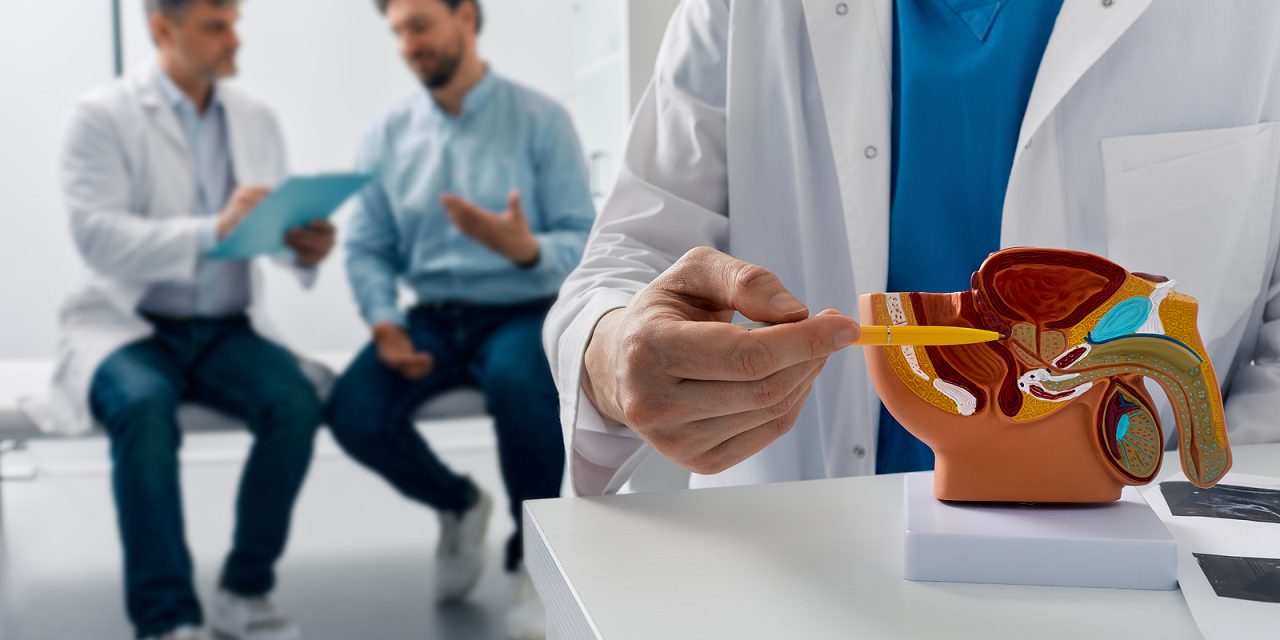Knowing when to get a prostate exam is crucial for maintaining men’s health, especially as they age. The prostate gland, a small walnut-shaped organ, plays an important role in the male reproductive system. However, it’s also prone to problems, such as benign prostatic hyperplasia (BPH), as men get older. Recognizing the symptoms of prostate problems is the first step towards seeking medical advice.
Typically, a prostate exam is recommended for men starting at the age of 50. Still, those with a family history of prostate cancer or other risk factors may need to begin screening earlier. During the exam, doctors may use several diagnostic procedures, including a digital rectal exam (DRE) and a prostate-specific antigen (PSA) test, to assess the health of the prostate. If enlargement is detected, treatment options vary depending on the severity of the symptoms, from medications to minimally invasive surgeries such as robotic waterjet treatment.
Key Takeaways
- Prostate exams are essential for detecting conditions like BPH and should begin at age 50 or earlier if risk factors exist.
- Diagnostic procedures can accurately assess prostate health and determine the presence of enlargement.
- Treatment options for prostate enlargement range from medication to innovative surgical procedures.
Understanding the Prostate Gland
The prostate gland plays a crucial role in male reproductive health, being integral to both urination and fertility. This small but significant gland has functions and an anatomy that are essential for understanding male health.
Function and Importance
The prostate gland produces a fluid that, when combined with sperm produced by the testicles, becomes semen. This fluid contains enzymes, prostate-specific antigen (PSA), and other substances crucial for sperm viability and fertility. Additionally, the prostate surrounds part of the urethra, the duct through which urine flows, playing a key role in urination control.
Anatomy of the Prostate
Anatomically, the prostate gland is a walnut-sized organ located just below the bladder and in front of the rectum in men. It encircles the urethra, which carries urine from the bladder out through the penis. The prostate is divided into several zones and is made up of muscular and epithelial tissues, which, under the influence of male hormones, grow and develop during puberty.
Recognizing Prostate Problems
Prostate issues, notably an enlarged prostate, can impede daily life and lead to complications if left unchecked. Understanding symptoms and recognizing potential complications early on is essential for maintaining prostate health and preventing more severe conditions.
Common Symptoms to Watch For
Men experiencing prostate problems may notice a range of urinary symptoms that signal an issue:
- Frequent urination, particularly at night
- Difficulty starting or holding a urine stream
- A weak or interrupted urine stream
- An urgency to urinate that is hard to control
- A feeling that the bladder has not fully emptied after urination
These symptoms suggest changes in prostate function, which may be due to an enlarged prostate or an infection such as a urinary tract infection (UTI).
Potential Complications
If prostate problems are not addressed, they can lead to more severe complications:
- Bladder stones: These are often a result of urine being retained in the bladder.
- Bladder infections: An enlarged prostate may impede urine flow, thereby increasing the risk of infection.
- Kidney problems: Prolonged bladder issues can eventually affect the kidneys, potentially leading to kidney damage or infection.
Individuals must consult their healthcare professional if they experience any urinary symptoms to prevent these potential complications.
When to Seek a Prostate Exam
Prostate exams are crucial for early detection and management of prostate-related issues. These evaluations often include a digital rectal exam and can measure prostate-specific antigen (PSA) levels. Knowing when to seek a prostate exam can help maintain prostate health and facilitate timely intervention if necessary.
Recommended Age and Frequency
Men should consider beginning prostate screenings at age 50. However, if they fall into higher risk categories, such as having a significant family history of the disease, it’s wise to start at age 45. Those with even higher risk factors, including African American heritage or a family member who had prostate cancer before age 65, should discuss starting at 40. The frequency of follow-up exams can vary depending on initial test results and should be determined by a healthcare provider.
Risk Factors and Family History
A family history of prostate cancer significantly increases the risk, warranting earlier and more frequent screenings. Additional risk factors include ethnicity, with African American men being at a higher risk, and lifestyle factors such as diet and exercise. Individuals with these risk factors should maintain an ongoing dialogue with their urologist to determine an appropriate screening regimen.
Signs and Symptoms Prompting Immediate Attention
Certain signs and symptoms indicate the need for an immediate prostate exam. These include, but are not limited to:
- Difficulty urinating or holding back urine
- Lower back pain, pelvic area or hips
- Blood in the urine or semen
- Erectile dysfunction
An enlarged prostate does not necessarily indicate cancer but may require management for quality of life. Screening can involve a digital rectal exam performed by a urologist to assess the prostate’s size and any irregularities. If there are concerns, a prostate-specific antigen test may be advised to check for elevated PSA levels, which can be a sign of prostate cancer or other conditions.
Diagnostic Procedures
Several diagnostic procedures are essential in assessing prostate health and identifying potential enlargement. These tests provide valuable information about the condition of the prostate and guide subsequent treatment decisions.
Digital Rectal Exam (DRE)
During a Digital Rectal Exam (DRE), a healthcare provider inserts a gloved, lubricated finger into the rectum to feel for irregularities on the prostate surface. This exam can reveal enlargement or abnormalities.
PSA Blood Test
The PSA Blood Test measures the level of prostate-specific antigens, a protein produced by prostate cells, in the blood. Elevated PSA levels can indicate an enlarged prostate, infection, inflammation, or, in some cases, cancer.
Ultrasound and MRI
For more detailed imaging, an ultrasound can be performed transrectally to visualize the prostate in real time. An MRI may be utilized to obtain high-resolution images of the prostate and surrounding tissues, assisting in accurate diagnosis.
Biopsy and Lab Tests
If the aforementioned tests indicate potential concerns, a prostate biopsy may be conducted, where tissue samples are collected and examined for signs of cancer. Lab tests analyze the removed tissue for cell types, PSA levels, and other prostate markers.
Understanding Benign Prostatic Hyperplasia (BPH)
Benign Prostatic Hyperplasia (BPH) is a condition marked by the enlargement of the prostate gland, which can impact urinary function in men, typically as they age.
What is BPH?
Benign Prostatic Hyperplasia (BPH) is a noncancerous increase in the size of the prostate gland. This small gland produces fluid for semen located below the bladder and surrounding the urethra. As BPH progresses, it can compress the urethra, which can lead to difficulty with urination and bladder emptying. This condition predominantly affects the outer part of the prostate, and the level of enlargement varies from person to person.
Causes and Development
BPH results from changes within the prostate tissue as men age. The bladder, neck, and the tissue around it, both parts of the prostate, are involved in developing BPH. The growth of the prostate is believed to be due to the fluctuating levels of male hormones. However, while all men experience prostate growth as they age, not all will develop BPH symptoms. It is not entirely understood why some men’s prostates enlarge to the point of causing symptoms while others do not.
Treatment Options for Prostate Enlargement
Prostate enlargement, medically referred to as benign prostatic hyperplasia (BPH), has several treatment options ranging from medication to surgery, depending on symptom severity and the individual’s health.
Medicinal Treatments
Medications are often the first line of defense for treating BPH:
- Alpha-blockers: They relax the muscles of the bladder and prostate, easing symptoms such as difficult urination. Examples include tamsulosin and alfuzosin.
- 5-alpha reductase inhibitors: These drugs, such as finasteride and dutasteride, shrink the prostate over time and prevent further growth.
- Combination therapy: For some men, using both alpha blockers and 5-alpha reductase inhibitors is more effective.
Side effects may include sexual dysfunction, dizziness, and other individual-specific reactions.
Minimally Invasive Procedures
These procedures require less recovery time than traditional surgery and include:
- Transurethral Microwave Thermotherapy: Microwaves help reduce prostate size by destroying excess tissue.
- Rezūm Water Vapor Therapy: A needle delivers steam to remove excess prostate tissue with minimal cuts.
Procedures like these may require the temporary use of a catheter and can result in side effects such as urinary tract infections or discomfort.
Surgical Interventions
When medication and minimally invasive methods are insufficient, surgery might be necessary:
- Transurethral Resection of the Prostate (TURP): This is a standard procedure where a portion of the prostate is removed without external incisions.
- Holmium Laser Enucleation of the Prostate (HoLEP): A laser removes tissue blocking urine flow and benefits men with larger prostates.
- Simple Prostatectomy: Generally, for very large prostates, it involves removing the inner part of the prostate.
Surgical risks can include bleeding, infection, and longer-term side effects such as sexual dysfunction or urinary incontinence.
Living with an Enlarged Prostate
Living with an enlarged prostate, also known as benign prostatic hyperplasia (BPH), typically involves managing symptoms through a combination of lifestyle adjustments and medical care. Effective management can alleviate the discomfort associated with urinary frequency, urgency, and other related issues.
Managing Symptoms
Individuals coping with BPH-related symptoms can take steps to ease their discomfort. Monitoring prostate-specific antigen (PSA) levels can help track prostate health. To manage urinary symptoms like urgency and frequency, one may be advised to schedule bathroom visits every few hours, even if the urge to urinate is absent. This can prevent the bladder from becoming overly full, which may worsen symptoms.
Lifestyle Adjustments
Simple lifestyle changes can significantly impact the management of BPH symptoms:
- Diet: Consuming foods low in spices and artificial additives may reduce bladder irritation.
- Fluid management: Limiting fluid intake in the evening can help reduce nocturia—the frequent need to urinate at night.
- Physical activity: Establishing a routine exercise schedule may improve urine flow and overall urinary health.
Monitoring and Ongoing Care
Ongoing care for an enlarged prostate includes regular medical checkups to assess the size of the prostate and the effectiveness of the treatment plan:
- Medications: Prescribed medicines can alleviate symptoms by shrinking the prostate or relaxing muscles near the prostate.
- Follow-up visits: Routine visits to the healthcare provider for symptom review and PSA tests are crucial.
Through consistent management and healthcare supervision, individuals with an enlarged prostate can maintain a comfortable quality of life.
Possible Complications of Prostate Enlargement
Prostate enlargement, known as benign prostatic hyperplasia (BPH), can lead to significant health issues if not managed properly. Complications can affect both the urinary system and sexual function.
Acute and Chronic Health Risks
Urinary Tract Complications:
- Bladder issues: BPH may cause bladder damage and frequent urinary tract infections.
- Urinary retention: Acute urinary retention can occur, requiring medical intervention to drain the bladder.
- Kidney damage: Extended urinary retention can cause pressure in the kidneys, potentially leading to kidney problems.
Bleeding Risks:
- Hematuria: Blood in the urine, or hematuria, is a possible complication due to irritation or damage to the urinary tract.
Impact on Sexual Function
Erectile Dysfunction (ED):
Ejaculatory Issues:
- Retrograde ejaculation: Surgery for BPH, like TURP, can lead to a condition where semen enters the bladder instead of exiting the penis during orgasm, known as retrograde ejaculation. This does not reduce sexual pleasure but can affect fertility.
Innovative Treatments and Emerging Research
Prostate health management is undergoing significant changes thanks to new treatments and ongoing research. These advancements offer promising alternatives to traditional therapies, aiming to improve patient outcomes and quality of life.
Recent Advances in Medicine
Water vapor thermal therapy, a newer, minimally invasive treatment, introduces steam into the prostate to remove excess tissue and alleviate the obstruction. This therapy represents a shift towards procedures with potentially fewer side effects and quicker recovery times.
Future Directions in Prostate Health
Emerging research indicates that the future of prostate treatment could be even more tailored and specific to individual needs. The focus is shifting towards precision medicine, wherein treatment is customized based on genetic, environmental, and lifestyle factors. This approach not only customizes care but also improves the detection and treatment of prostate conditions.
Continuous research and clinical trials are the key to understanding how pre-existing treatments like alpha-blockers and 5-alpha reductase inhibitors can be integrated with new therapies to enhance patient care. This convergence of traditional and innovative treatments holds the potential to significantly elevate the standards of prostate health in the coming years.
Conclusion
In terms of prostate health, it is crucial to consult with a urologist for an accurate diagnosis and appropriate treatment. Men should commence regular screening for prostate issues, including a prostate exam, starting between the ages of 45 to 50 or earlier if they have certain risk factors. The procedures for evaluating prostate function can help detect conditions such as benign prostatic hyperplasia (BPH) and prostate cancer in their early stages.
For treatment of prostate enlargement, various options are available, ranging from medications like alpha-blockers, which can alleviate symptoms by relaxing the bladder and prostate muscles, to more invasive procedures. Exploring these treatment options with a urologist is critical to managing symptoms effectively.
Additionally, a healthy lifestyle—focusing on a balanced diet, regular physical activity, and maintaining a healthy weight—may contribute to better prostate health and lower the risk of complications.
Regular screening remains a critical component for men as they age, as it facilitates early detection and management of prostate issues. Urologists can provide personalized guidance on screening schedules based on individual health profiles.
Frequently Asked Questions
Prostate health is a critical aspect of men’s overall well-being. This section addresses common inquiries about prostate screening and treatment.
How often should men undergo routine prostate screening?
Men should consider routine prostate screenings beginning at age 50, but those with risk factors such as a family history of prostate cancer may begin as early as age 45. Frequency of these exams should be discussed with a healthcare provider.
At what age is it recommended for men to start prostate examinations?
The American Cancer Society suggests men start prostate exams at age 50 or age 45 for those with a higher risk due to family history or other factors.
What are the common symptoms indicating the need for a prostate exam?
Symptoms that may prompt a prostate exam include urinary difficulties, such as increased frequency, hesitancy, or urgency; blood in urine; pain during urination; and pelvic discomfort.
What non-invasive options are available for prostate cancer detection?
A PSA screening test is a non-invasive blood test that can detect prostate cancer. This test measures the level of prostate-specific antigen in the blood.
What preparation is necessary before a prostate examination?
Typically, no special preparation is required for a digital rectal exam. However, for a PSA test, one may be advised to avoid ejaculation, exercise, or certain medications that can affect PSA levels for a short period before the test.
How is prostate enlargement typically managed or treated?
Management of prostate enlargement, or benign prostatic hyperplasia (BPH), may include medications such as alpha-blockers and 5-alpha-reductase inhibitors. In more severe cases, minimally invasive surgeries or traditional surgical procedures can be necessary.














